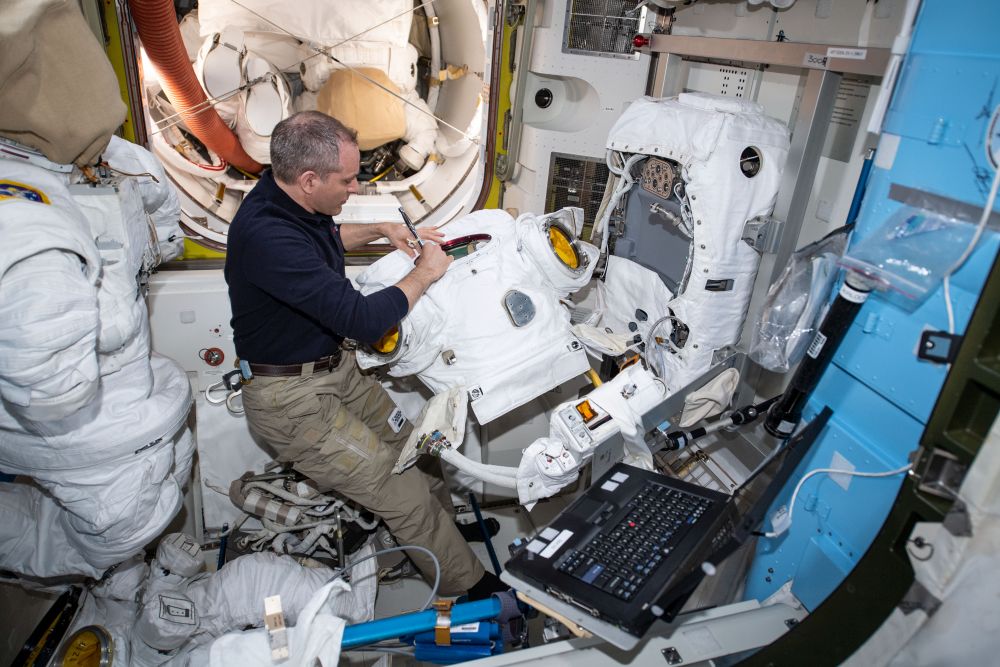The all-female astronaut walk is back on.
Back on March 26th, 2019, NASA was forced to cancel the first all-female spacewalk because they didn’t have the right spacesuits available on the ISS. There was a short-lived social media storm over that development, as some claimed it was evidence of sexism on the part of NASA. But that small storm didn’t have legs and it died out, because no serious-minded observer thinks that NASA is actually sexist.
Now, the problem has been worked out, and the spacewalk will happen on October 21st, when astronauts Christina Koch and Jessica Meir will walk outside the ISS and install new lithium-ion batteries. Theirs is the first of five walks needed to complete the installation.
The cancellation of the original spacewalk was all about safety, not sexism.
Originally, the two astronauts scheduled for the first all-female spacewalk were rookie astronauts Anne McClain and Christina Koch. McClain had already walked in space on that mission on March 2nd, along with Nick Hague. But during that walk, McClain encountered a problem: the torso size didn’t fit her. In microgravity, an astronaut’s body stretches, and a suit size that fit during pool-testing on Earth may not fit the same in space.
After she completed her spacewalk, McClain told NASA ground personnel about it and they responded with a decision. The dual female spacewalk would be split into two walks, because there was only one suit with the correct torso fit for McClain and Koch. It’s unsafe to send someone outside the ISS with equipment that may have a problem with fit.
“McClain learned during her first spacewalk that a medium-size hard upper torso – essentially the shirt of the spacesuit – fits her best. Because only one medium-size torso can be made ready by Friday, March 29, Koch will wear it,” NASA said in a statement. So they both got to spacewalk, just not together.

While we call them spacesuits, they’re actually called Extravehicular Mobility Units (EMUs.) Though they’re robust, they have to be handled with care, and used safely. They’re sort of modular, so they can be configured with different torso sections and arms and legs for a better fit. But that takes time, and it’s better done on the ground. That’s because they can only be maintained on the ground, and if something goes wrong during reconfiguring, the suit may be out of commission. That would just hinder any further plans.
Another problem with reconfiguring EMUs on the ISS is the time. It can take up to 12 hours to replace the torso, or Hard Upper Torso (HUT) as it’s called. Water inside the suit must be cleaned and checked for contamination; hardware must be physically changed out; and the various suit systems must be verified with the ground crews to confirm the suit is safe and ready to wear.
But time on the ISS is extremely valuable. There’s important science to be done, maintenance tasks and cleaning to perform, and of course sleeping and exercising. Using that valuable time to work on EMUs is not the best use of time.
At the time of the cancellation, NASA’s Stephanie Schierholz tried to clear things up on Twitter.
But that’s all history now.
It should be obvious to any observer that being an astronaut is very dangerous. As if spacewalks aren’t risky enough, there’s lift-offs and landings, too. Astronaut safety is more important than any gender politics. And none of these spacewalks happen in a vacuum. Activities on the ISS are on a strict schedule, with science needs, resupply craft arrivals, and other tasks all planned in advance.
Thankfully, it’s back on, and the first all-female spacewalk is likely to be an historic mission. In an interview on NASA TV, Christina Koch said, “In the end, I do think it’s important because of the historical nature of what we’re doing and in the past, women haven’t always been at the table.”
Now they’re not only at the table, they’re walking in space.

